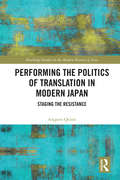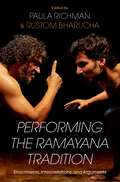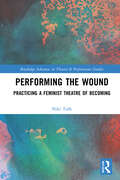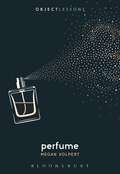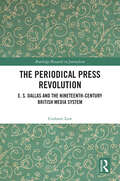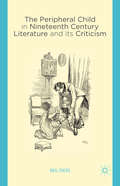- Table View
- List View
Performing the Past: A Study of Israeli Settlement Museums (Everyday Communication Series)
by Tamar KatrielA nostalgic interest in the past is a well-recognized feature of fast-changing, contemporary societies. It finds its expression in a variety of history-making practices of which the establishment of local heritage museums is a major manifestation in many parts of the world today. Katriel develops a communication-centered perspective on the study of heritage museums and -- by extension -- other tourist sites, highlighting the role of discourse in these institutionalized, yet vernacular contexts of cultural production, social legitimation, and identity formation. Descriptive and critical in orientation, this book combines a close analysis of museum discourse with an exploration of such larger issues as: * the socio-cultural role of museums as arenas for the production of collective memory, * the ideological and performative constraints that shape museum presentations, * the interfacing of verbal and visual codes of communication in the context of material displays, * the dialectical interplay of the local and the global in contemporary life, and * the interpenetration of the personal and the communal in vernacular processes of narrative production. Of interest to scholars in communication, linguistics, anthropology, history, museum studies, tourism, intercultural communication, middle eastern studies, or those with interests in narratives, material culture, and ethnography.
Performing the Politics of Translation in Modern Japan: Staging the Resistance (Routledge Studies in the Modern History of Asia)
by Aragorn QuinnPerforming the Politics of Translation in Modern Japan sheds new light on the adoption of concepts that motivated political theatres of resistance for nearly a century and even now underpin the collective understanding of the Japanese nation. Grounded in the aftermath of the Meiji Restoration in 1868 and analyzing its legacy on stage, this book tells the story of the crucial role that performance and specifically embodied memory played in the changing understanding of the imported Western concepts of "liberty" (jiyū) and "revolution" (kakumei). Tracing the role of the post-Restoration movement itself as an important touchstone for later performances, it examines two key moments of political crisis. The first of these is the Proletarian Theatre Movement of the 1920s and '30s, in which the post-Restoration years were important for theorizing the Japanese communist revolution. The second is in the postwar years when Rights Movement theatre and thought again featured as a vehicle for understanding the present through the past. As such, this book presents the translation of "liberty" and "revolution", not through a one-to-one correspondence model, but rather as a many-to-many relationship. In doing so, it presents a century of evolution in the dramaturgy of resistance in Japan. This book will be useful to students and scholars of Japanese history, society and culture, as well as literature and translation studies alike.
Performing the Politics of Translation in Modern Japan: Staging the Resistance (Routledge Studies in the Modern History of Asia)
by Aragorn QuinnPerforming the Politics of Translation in Modern Japan sheds new light on the adoption of concepts that motivated political theatres of resistance for nearly a century and even now underpin the collective understanding of the Japanese nation. Grounded in the aftermath of the Meiji Restoration in 1868 and analyzing its legacy on stage, this book tells the story of the crucial role that performance and specifically embodied memory played in the changing understanding of the imported Western concepts of "liberty" (jiyū) and "revolution" (kakumei). Tracing the role of the post-Restoration movement itself as an important touchstone for later performances, it examines two key moments of political crisis. The first of these is the Proletarian Theatre Movement of the 1920s and '30s, in which the post-Restoration years were important for theorizing the Japanese communist revolution. The second is in the postwar years when Rights Movement theatre and thought again featured as a vehicle for understanding the present through the past. As such, this book presents the translation of "liberty" and "revolution", not through a one-to-one correspondence model, but rather as a many-to-many relationship. In doing so, it presents a century of evolution in the dramaturgy of resistance in Japan. This book will be useful to students and scholars of Japanese history, society and culture, as well as literature and translation studies alike.
Performing the Ramayana Tradition: Enactments, Interpretations, and Arguments
by Paula Richman and Rustom BharuchaThe Ramayana, one of the two pre-eminent Hindu epics, has played a foundational role in many aspects of India's arts and social norms. For centuries, people learned this narrative by watching, listening, and participating in enactments of it. Although the Ramayana's first extant telling in Sanskrit dates back to ancient times, the story has continued to be retold and rethought through the centuries in many of India's regional languages, such as Hindi, Tamil, and Bengali. The narrative has provided the basis for enactments of its episodes in recitation, musical renditions, dance, and avant-garde performances. This volume introduces non-specialists to the Ramayana's major themes and complexities, as well as to the highly nuanced terms in Indian languages used to represent theater and performance. Two introductions orient readers to the history of Ramayana texts by Tulsidas, Valmiki, Kamban, Sankaradeva, and others, as well as to the dramaturgy and aesthetics of their enactments. The contributed essays provide context-specific analyses of diverse Ramayana performance traditions and the narratives from which they draw. The essays are clustered around the shared themes of the politics of caste and gender; the representation of the anti-hero; contemporary re-interpretations of traditional narratives; and the presence of Ramayana discourse in daily life.
Performing the Ramayana Tradition: Enactments, Interpretations, and Arguments
The Ramayana, one of the two pre-eminent Hindu epics, has played a foundational role in many aspects of India's arts and social norms. For centuries, people learned this narrative by watching, listening, and participating in enactments of it. Although the Ramayana's first extant telling in Sanskrit dates back to ancient times, the story has continued to be retold and rethought through the centuries in many of India's regional languages, such as Hindi, Tamil, and Bengali. The narrative has provided the basis for enactments of its episodes in recitation, musical renditions, dance, and avant-garde performances. This volume introduces non-specialists to the Ramayana's major themes and complexities, as well as to the highly nuanced terms in Indian languages used to represent theater and performance. Two introductions orient readers to the history of Ramayana texts by Tulsidas, Valmiki, Kamban, Sankaradeva, and others, as well as to the dramaturgy and aesthetics of their enactments. The contributed essays provide context-specific analyses of diverse Ramayana performance traditions and the narratives from which they draw. The essays are clustered around the shared themes of the politics of caste and gender; the representation of the anti-hero; contemporary re-interpretations of traditional narratives; and the presence of Ramayana discourse in daily life.
Performing the Wound: Practicing a Feminist Theatre of Becoming (Routledge Advances in Theatre & Performance Studies)
by Niki TulkThis book offers a matrixial, feminist-centered analysis of trauma and performance, through examining the work of three artists: Ann Hamilton, Renée Green, and Cecilia Vicuña. Each artist engages in a multi-media, or “combination” performance practice; this includes the use of site, embodied performance, material elements, film, and writing. Each case study involves traumatic content, including the legacy of slavery, child sexual abuse and environmental degradation; each artist constructs an aesthetic milieu that invites rather than immerses—this allows an audience to have agency, as well as multiple pathways into their engagement with the art. The author Niki Tulk suggests that these works facilitate an audience-performance relationship based on the concept of ethical witnessing/wit(h)nessing, in which viewers are not positioned as voyeurs, nor made to risk re-traumatization by being forced to view traumatic events re-played on stage. This approach also allows agency to the art itself, in that an ethical space is created where the art is not objectified or looked at—but joined with. Foundational to this investigation are the writings of Bracha L. Ettinger, Jill Bennett and Diana Taylor—particularly Ettinger’s concepts of the matrixial, carriance and border-linking. These artists and scholars present a capacity to expand and articulate answers to questions regarding how to make performance that remains compelling and truthful to the trauma experience, but not re-traumatizing. This study will be of great interest to students and scholars of performance studies, art history, visual arts, feminist studies, theatre, film, performance art, postcolonialism, rhetoric and writing.
Performing the Wound: Practicing a Feminist Theatre of Becoming (Routledge Advances in Theatre & Performance Studies)
by Niki TulkThis book offers a matrixial, feminist-centered analysis of trauma and performance, through examining the work of three artists: Ann Hamilton, Renée Green, and Cecilia Vicuña. Each artist engages in a multi-media, or “combination” performance practice; this includes the use of site, embodied performance, material elements, film, and writing. Each case study involves traumatic content, including the legacy of slavery, child sexual abuse and environmental degradation; each artist constructs an aesthetic milieu that invites rather than immerses—this allows an audience to have agency, as well as multiple pathways into their engagement with the art. The author Niki Tulk suggests that these works facilitate an audience-performance relationship based on the concept of ethical witnessing/wit(h)nessing, in which viewers are not positioned as voyeurs, nor made to risk re-traumatization by being forced to view traumatic events re-played on stage. This approach also allows agency to the art itself, in that an ethical space is created where the art is not objectified or looked at—but joined with. Foundational to this investigation are the writings of Bracha L. Ettinger, Jill Bennett and Diana Taylor—particularly Ettinger’s concepts of the matrixial, carriance and border-linking. These artists and scholars present a capacity to expand and articulate answers to questions regarding how to make performance that remains compelling and truthful to the trauma experience, but not re-traumatizing. This study will be of great interest to students and scholars of performance studies, art history, visual arts, feminist studies, theatre, film, performance art, postcolonialism, rhetoric and writing.
Performing Transversally: Reimagining Shakespeare and the Critical Future
by Bryan ReynoldsPerforming Transversally expands on Bryan Reynolds' controversial transversal theory in exciting ways while offering groundbreaking analyses of Shakespeare's plays - Hamlet , Othello , Macbeth , Taming of the Shrew , Titus Andronicus , Henry V , The Tempest , and Coriolanus - and textual, filmic, and theatrical adaptations of them. With his collaborators, Reynolds challenges traditional readings of Shakespeare, re-evaluating the critical methodologies that characterize them, in regard to issues of cultural difference, authorship, representation, agency, and iconography. Reynolds demonstrates the value of his 'investigative-expansive mode,' outlining a 'transversal poetics' that points toward a critical future that is more aware of its subjective interconnectedness with the topics and audiences it seeks to engage than is reflected in most Shakespeare criticism and literary-cultural scholarship.
Performing women: Gender, self, and representation in late medieval Metz (Manchester Medieval Literature and Culture)
by Susannah CrowderThis book takes on a key problem in the history of drama: the ‘exceptional’ staging of the life of Catherine of Siena by a female actor and a female patron in 1468 Metz. Exploring the lives and performances of these previously anonymous women, the book brings the elusive figure of the female performer to centre stage. It integrates new approaches to drama, gender and patronage with a performance methodology to explore how the women of fifteenth-century Metz enacted varied kinds of performance that extended beyond the theatre. For example, decades before the 1468 play, Joan of Arc returned from the grave in the form of an impersonator named Claude. Offering a new paradigm of female performance that positions women at the core of public culture, Performing women is essential reading for scholars of pre-modern women and drama, and is also relevant to lecturers and students of late-medieval performance, religion and memory.
Performing women: Gender, self, and representation in late medieval Metz (Manchester Medieval Literature and Culture)
by Susannah CrowderThis book takes on a key problem in the history of drama: the ‘exceptional’ staging of the life of Catherine of Siena by a female actor and a female patron in 1468 Metz. Exploring the lives and performances of these previously anonymous women, the book brings the elusive figure of the female performer to centre stage. It integrates new approaches to drama, gender and patronage with a performance methodology to explore how the women of fifteenth-century Metz enacted varied kinds of performance that extended beyond the theatre. For example, decades before the 1468 play, Joan of Arc returned from the grave in the form of an impersonator named Claude. Offering a new paradigm of female performance that positions women at the core of public culture, Performing women is essential reading for scholars of pre-modern women and drama, and is also relevant to lecturers and students of late-medieval performance, religion and memory.
Performing Women: Stand-ups, Strumpets and Itinerants
by Alison OddeyAlison Oddey's interviews with prominent performing women span generations, cultures, perspectives, practice and the best part of the twentieth century, telling various stories collectively. Stand-ups, 'classic' actresses, film and television personalities, experimental and 'alternative' practitioners discuss why they want to perform, what motivates them, and how their personal history has contributed to their desires to perform. Oddey's critical introductory and concluding chapters analyse both historical and cultural contexts and explore themes arising from interviews. These include sense of identity, acting as playing (recapturing and revisiting childhood), displacement of roots, performing, motherhood and 'being', performing comedy, differences between theatre, film and television performance, attitudes towards and relationships with audiences, and working with directors. The prominent subtext of motherhood reveals a consciousness of split subjectivities with and beyond performance.
Performing Women: Stand-Ups, Strumpets and Itinerants
by Alison OddeyAlison Oddey's interviews with prominent performing women span generations, cultures, perspectives, practice and the best part of the twentieth-century, telling various stories collectively. Stand-ups, 'classic' actresses, film and television personalities, experimental and 'alternative' practitioners discuss why they want to perform, what motivates them, and how their personal history has contributed to their desire to perform. Oddey's critical introductory and concluding chapters analyze both historical and cultural contexts and explore themes arising from the interviews. These include sense of identity, acting as playing (recapturing and revisiting childhood), displacement of roots, performing, motherhood and 'being', performing comedy, differences between theatre, film and television performance, attitudes towards and relationships with audiences, and working with directors. The prominent subtext of motherhood reveals a consciousness of split subjectives with and beyond performance. This new edition of the book includes three new interviews with actresses, and is useful primary resource material for undergraduate students on performance studies courses.
Perfume (Object Lessons)
by Megan VolpertObject Lessons is a series of short, beautifully designed books about the hidden lives of ordinary things.Our sense of smell is crucial to our survival. We can smell fear, disease, food. Fragrance is also entertainment. We can smell an expensive bottle of perfume at a high-end department store. Perhaps it reminds us of our favorite aunt. A memory in a bottle is a powerful thing. Megan Volpert's Perfume carefully balances the artistry with the science of perfume. The science takes us into the neurology of scent receptors, how taste is mostly smell, the biology of illnesses that impact scent sense, and the chemistry of making and copying perfume. The artistry of perfume involves the five scent families and symbolism, subjectivity in perfume preference, perfume marketing strategies, iconic scents and perfumers, why the industry is so secretive, and Volpert's own experiments with making perfume. Object Lessons is published in partnership with an essay series in The Atlantic.
Perfume (Object Lessons)
by Megan VolpertObject Lessons is a series of short, beautifully designed books about the hidden lives of ordinary things.Our sense of smell is crucial to our survival. We can smell fear, disease, food. Fragrance is also entertainment. We can smell an expensive bottle of perfume at a high-end department store. Perhaps it reminds us of our favorite aunt. A memory in a bottle is a powerful thing. Megan Volpert's Perfume carefully balances the artistry with the science of perfume. The science takes us into the neurology of scent receptors, how taste is mostly smell, the biology of illnesses that impact scent sense, and the chemistry of making and copying perfume. The artistry of perfume involves the five scent families and symbolism, subjectivity in perfume preference, perfume marketing strategies, iconic scents and perfumers, why the industry is so secretive, and Volpert's own experiments with making perfume. Object Lessons is published in partnership with an essay series in The Atlantic.
Perilous Passages: The Book of Margery Kempe, 1534–1934 (The New Middle Ages)
by Julie ChappellThis study will significantly further our interpretations of the unique autobiography of Margery Kempe, lay woman turned mystic and visionary. Following the manuscript from a Carthusian monastery through history, Chappell bridges the gaps in our understanding of the transmission of texts from the medieval past to the present.
The Perils of Print Culture: Book, Print and Publishing History in Theory and Practice (New Directions in Book History)
by Jason McElligottThis collection of essays illustrates various pressures and concerns—both practical and theoretical—related to the study of print culture. Procedural difficulties range from doubts about the reliability of digitized resources to concerns with the limiting parameters of 'national' book history.
Perils of the Night: A Feminist Study of Nineteenth-Century Gothic
by Eugenia C. DeLamotteThis book argues that the source of Gothic terror is anxiety about the boundaries of the self: a double fear of separateness and unity that has had a special significance for women writers and readers. Exploring the psychological, religious, and epistemological context of this anxiety, DeLamotte argues that the Gothic vision focuses simultaneously on the private demons of the psyche and the social realities that helped to shape them. Her analysis includes works of English and American authors, among them Henry James, Mary Shelley, Herman Melville, Nathaniel Hawthorne, Emily Brontë, Charlotte Brontë, and a number of often neglected popular women Gothicists.
The Periodical Press in Nineteenth-Century Ireland (New Directions in Book History)
by Elizabeth TilleyThis book offers a new interpretation of the place of periodicals in nineteenth-century Ireland. Case studies of representative titles as well as maps and visual material (lithographs, wood engravings, title-pages) illustrate a thriving industry, encouraged, rather than defeated by the political and social upheaval of the century. Titles examined include: The Irish Magazine, and Monthly Asylum for Neglected Biography and The Irish Farmers’ Journal, and Weekly Intelligencer; The Dublin University Magazine; Royal Irish Academy Transactions and Proceedings and The Dublin Penny Journal; The Irish Builder (1859-1979); domestic titles from the publishing firm of James Duffy; Pat and To-Day’s Woman. The Appendix consists of excerpts from a series entitled ‘The Rise and Progress of Printing and Publishing in Ireland’ that appeared in The Irish Builder from July of 1877 to June of 1878. Written in a highly entertaining, anecdotal style, the series provides contemporary information about the Irish publishing industry.
The Periodical Press Revolution: E. S. Dallas and the Nineteenth-Century British Media System (Routledge Research in Journalism)
by Graham LawThis book explores a key aspect of journalism history from a sociological perspective: the rise of the periodical press. With a focus not on the economic and technological causes of this revolution but on the social and political consequences, the book takes a global look at this key development in the British press.Taking as a point of departure the theory of E.S. Dallas, who defined the periodical as 'the great event in modern history', the book explores these premises and conclusions regarding authorship, publishing, and readership, considering the nineteenth century as a whole. After an introductory section discussing questions of theory and method, the analysis first offers an overview of the quantitative growth of the periodical market, whether measured in terms of publications, readership, or authorship, before turning to a more detailed consideration of its qualitative determinants and effects, again distinguishing the same three aspects.Offering new insight into this key turning point in journalism history, this book will be of interest to all students and scholars of journalism and journalism history, media history, media and communication studies, British history, and modern history.
The Periodical Press Revolution: E. S. Dallas and the Nineteenth-Century British Media System (Routledge Research in Journalism)
by Graham LawThis book explores a key aspect of journalism history from a sociological perspective: the rise of the periodical press. With a focus not on the economic and technological causes of this revolution but on the social and political consequences, the book takes a global look at this key development in the British press.Taking as a point of departure the theory of E.S. Dallas, who defined the periodical as 'the great event in modern history', the book explores these premises and conclusions regarding authorship, publishing, and readership, considering the nineteenth century as a whole. After an introductory section discussing questions of theory and method, the analysis first offers an overview of the quantitative growth of the periodical market, whether measured in terms of publications, readership, or authorship, before turning to a more detailed consideration of its qualitative determinants and effects, again distinguishing the same three aspects.Offering new insight into this key turning point in journalism history, this book will be of interest to all students and scholars of journalism and journalism history, media history, media and communication studies, British history, and modern history.
Peripheral Actors in Journalism: Deviating from the Norm? (Routledge Focus on Journalism Studies)
by Aljosha Karim SchapalsThis book addresses the transformative role that so-called peripheral actors in journalism – emerging outlets diverging from the norms fiercely held by mainstream media outlets – play in today’s news ecosystem. The author charts the rise to prominence of these actors, outlining how they have successfully managed to challenge the authority held by mainstream, legacy outlets, whose claims to be the “storytellers of our time” no longer exclusively pertain to them. Beginning by identifying these peripheral actors specifically, the book then considers whether what they do is “journalism” as traditionally conceived, what their motivations are, and why their role is important in light of journalism’s democratic function in holding power to account. Ultimately, it is argued that, despite the perceived role of peripheral actors as “deviant”, they still demonstrate a surprising degree of ideological continuity in the face of industrial disruption. Drawing on research from Australia, Germany, and the United Kingdom, Peripheral Actors in Journalism is an insightful resource for journalism and media scholars with an interest in alternative media sources.
Peripheral Actors in Journalism: Deviating from the Norm? (Routledge Focus on Journalism Studies)
by Aljosha Karim SchapalsThis book addresses the transformative role that so-called peripheral actors in journalism – emerging outlets diverging from the norms fiercely held by mainstream media outlets – play in today’s news ecosystem. The author charts the rise to prominence of these actors, outlining how they have successfully managed to challenge the authority held by mainstream, legacy outlets, whose claims to be the “storytellers of our time” no longer exclusively pertain to them. Beginning by identifying these peripheral actors specifically, the book then considers whether what they do is “journalism” as traditionally conceived, what their motivations are, and why their role is important in light of journalism’s democratic function in holding power to account. Ultimately, it is argued that, despite the perceived role of peripheral actors as “deviant”, they still demonstrate a surprising degree of ideological continuity in the face of industrial disruption. Drawing on research from Australia, Germany, and the United Kingdom, Peripheral Actors in Journalism is an insightful resource for journalism and media scholars with an interest in alternative media sources.
The Peripheral Child in Nineteenth Century Literature and its Criticism
by N. CocksEstablished accounts of the child in nineteenth century literature tend to focus on those who occupy a central position within narratives. This book is concerned with children who are not so easily recognized or remembered, the peripheral or overlooked children to be read in works by Dickens, Brontë, Austen and Rossetti.
Peripheral Visions for Writing Centers
by Jackie Grutsch McKinneyPeripheral Visions for Writing Centers aims to inspire a re-conception and re-envisioning of the boundaries of writing center work. Moving beyond the grand narrative of the writing center—that it is solely a comfortable, yet iconoclastic place where all students go to get one-to-one tutoring on their writing—McKinney shines light on other representations of writing center work. McKinney argues that this grand narrative neglects the extent to which writing center work is theoretically and pedagogically complex, with ever-changing work and conditions, and results in a straitjacket for writing center scholars, practitioners, students, and outsiders alike. Peripheral Visions for Writing Centers makes the case for a broader narrative of writing center work that recognizes and theorizes the various spaces of writing center labor, allows for professionalization of administrators, and sees tutoring as just one way to perform writing center work. McKinney explores possibilities that lie outside the grand narrative, allowing scholars and practitioners to open the field to a fuller, richer, and more realistic representation of their material labor and intellectual work.
Peripheral Visions / Global Sounds: From Galicia to the World (Contemporary Hispanic and Lusophone Cultures #16)
by José ColmeiroGalician audio/visual culture has experienced an unprecedented period of growth following the process of political and cultural devolution in post-Franco Spain. This creative explosion has occurred in a productive dialogue with global currents and with considerable projection beyond the geopolitical boundaries of the nation and the state, but these seismic changes are only beginning to be the subject of attention of cultural and media studies. This book examines contemporary audio/visual production in Galicia as privileged channels through which modern Galician cultural identities have been imagined, constructed and consumed, both at home and abroad. The cultural redefinition of Galicia in the global age is explored through different media texts (popular music, cinema, video) which cross established boundaries and deterritorialise new border zones where tradition and modernity dissolve, generating creative tensions between the urban and the rural, the local and the global, the real and the imagined. The book aims for the deperipheralization and deterritorialization of the Galician cultural map by overcoming long-established hegemonic exclusions, whether based on language, discipline, genre, gender, origins, or territorial demarcation, while aiming to disjoint the center/periphery dichotomy that has relegated Galician culture to the margins. In essence, it is an attempt to resituate Galicia and Galician studies out of the periphery and open them to the world.

